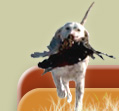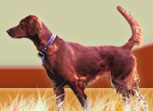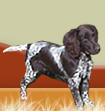|
|
 |
 |
Forty Years Between Labs
by Christian Hageseth III, M.D. (Copyright, 1999)
October, 1999
Fort Collins, Colorado
In a way, forty years doesn't seem all that long. Then, again, it feels like a lifetime; since that's what it is . . . almost. I was eighteen and hunting with my best friend, John Kermott. We were a couple high school seniors in Minot, North Dakota. We squeezed every moment of hunting pleasure from the hours remaining after school, parents, and part-time jobs had their say. And it was never enough. Duck hunting always started October First, a date forever etched in my memory. Duck hunting ended whenever North Dakota froze over, sometimes just a short three weeks later.
One cold late October day in 1958, John and I crept our way through clattering cattails, and then slithered out over half frozen ooze with its pungent, ripe odor filling our nostrils. We were hoping to get in range of an immense flock of northerners-late arriving and very smart mallards from northern Canada. These were experienced birds, used to being hunted and ready to jump at the first sign of anything amiss. At a "sit-stay" back at the edge of the cattails was Midge, my mostly-lab, the dog my parents insisted I accept from neighbors rather than going out and buying a real lab. The money simply wasn't there. And no matter, Midge had turned out to be a jewel, a retrieving maniac who only wanted to please.
We didn't get close enough to them before the enormous flock- maybe two hundred richly colored birds-leapt into flight. We emptied our guns at the departing birds. John shot a three inch 12 gauge and we saw one drake drop behind the flock and glide out toward the middle of the lake. This was a lake, not a pond; nearly a mile across and three miles long. As we saw the duck alight, it disappeared from sight on the horizon. Midge had not come forward, she had not been released. We wondered if we climbed the adjacent bluff that just maybe we could see the bird. With Midge at heel, we hiked up the grassy, sage covered bluff. There, through our binocs, we saw the granddaddy of all curly-tailed northern drake mallards way out in the lake but looking none too well. His head was tilted forward rather than being perched upright.
Johnny said, "Think she can do it?"
Said I, "We'll give her a try."
Midge knew a little bit about hand signals. On the first "back" command she ran down to the edge of the water, splashed around a bit, and took a drink. I whistled, she looked back and I gave her another "back." She swam out a bit further but then cast about since she saw nothing. There was a ferocious wind that gray morning and sharp little snowflakes jabbed at our faces like ever so tiny ice picks.
We turned our shoulders and shielded our faces as Midge swam on. When I whistled again she didn't respond. Not like her, I thought. Then it dawned on me she couldn't hear me. John and I climbed higher on the hill, the better for Midge to see us. And then that wonderful little dog (she only weighed about fifty pounds-mostly lab) periodically looked back and whatever my outstretched arm indicated, she did. Finally she saw the drake and the chase was on. She would swim close only to have the bird dive. Wait awhile for it to resurface and try again. It took her fifteen minutes to finally dive under and come up with a duck so large we could no longer see her head. It took her nearly twenty minutes to get back. On shore she dropped the bird to adjust her hold, take a breather and shake. The duck was off and swimming and a short chase ensued once again. Finally, half dragging the bird, sometimes tripping over its wings, Midge gamely charged up the hill. She delivered the most beautiful curly-tailed mallard drake to my hand. The bird was quite alive though a few feathers were out of place. And Midge grinned from ear to ear as only a happy dog can when she has done well. The whole retrieve took five minutes less than an hour.
Every time John and I got together over the ensuing eight years, we smoked our pipes and sat back and retold the story of the retrieve. Eight years I say because then John and Midge died. My dad died about the same time too. An auto accident for John, old age for Midge, prostate cancer for my dad. During those eight years John hunted with Midge but I couldn't. I had college and medical school to attend to. After that there were the Viet Nam years. For me it meant becoming a Marine Corps flight surgeon. Then there was raising a family, more education, compromise dogs, divorce and scant time and few places to hunt. I didn't have a John or a Midge. Unfortunately I have no pictures of John or Midge either. In 1969 a burglar stole my slide collection mistaking it for something he could sell. The pictures were priceless to me and worthless to him. Then again, losses were the name of the game in those days.
Forty years have passed. Much too long. I am fifty-eight, a moderately burned-out psychiatrist with two grown children and a lovely wife. A year ago Laurel insisted, "Don't compromise on dogs, get the dog of your dreams." The year before, she discovered a wonderful pup for herself at a pet shop in the mall. (We both cringe a bit when we admit that fact.) A product of purebred parents of different breeds, she is a "cuddle dog," agility dog, and therapy dog but not a real hunting dog. Laurel named her Breeze, a sweet dog who has turned into a phenomenal bird finder, but she is not the dog of my dreams. So I did what my sweet wife suggested, I bought the most wonderful British Labrador; all black, just like Midge. My new best friend is named Jessie, she is four and a half months old.
Yesterday, my thirty-two year old son (named John, of course) and I took Breeze and Jessie out to Western Wildlife Adventures for Jessie's second experience with live birds. During her first time out she seemed to get the big picture and discovered that feathers in the mouth can be fun. Maybe it's similar to how we humans enjoy a mouthful of sunflower seeds, the spitting is half the fun. Tim, the manager, told us he had planted seven quail and six chukar. The day was cool, gray, and windy with just a hint of snow flakes stinging our faces. After all, it is October. John and I haven't hunted together since he graduated from high school. Even though these were preserve birds, not wild, there was still the joy of hunting with John over dogs. As Tim drove away, he mentioned there had been some dog trials on this land last week and we might just pick up a left over pheasant or two.
Well, what can I say. Breeze and Jessie pointed and/or flushed over thirty-five birds that morning. Jessie found four on her own. John and I shot twenty five birds. Ten pheasants, ten quail, and five chukar. Since Breeze has an aversion to anything feathery in her mouth, Jessie retrieved every single bird-each with boundless joy and enthusiasm. A mere eighteen weeks old, Jessie found that some of the lively ringneck roosters were huge-vastly more than a mouthful for such a little dog. But she dragged them through tall grass, thick brush and clattering cattails; the birds kicking and cackling trying vainly to get free. She held them by a leg or a wing when she couldn't get a good hold. Once she even swam a stream, climbed a twenty foot bank and found quail I had dropped on the other side. She brought every single bird all the way back to hand. Just as Midge did forty years ago, Jessie grinned from ear to ear. Just as his namesake did forty years ago, John slapped my back and praised this wonderful little lab (she is all lab-British to be precise). The delight I felt forty years ago with John and Midge returned to me. How could an old guy not get all choked up? I couldn't.
I only have enough life for a couple more bird dogs. I promise I will make the most of it. And to you young guys: Don't let forty years go between memorable times with your best friend and your best dog.
|
|
|
|















